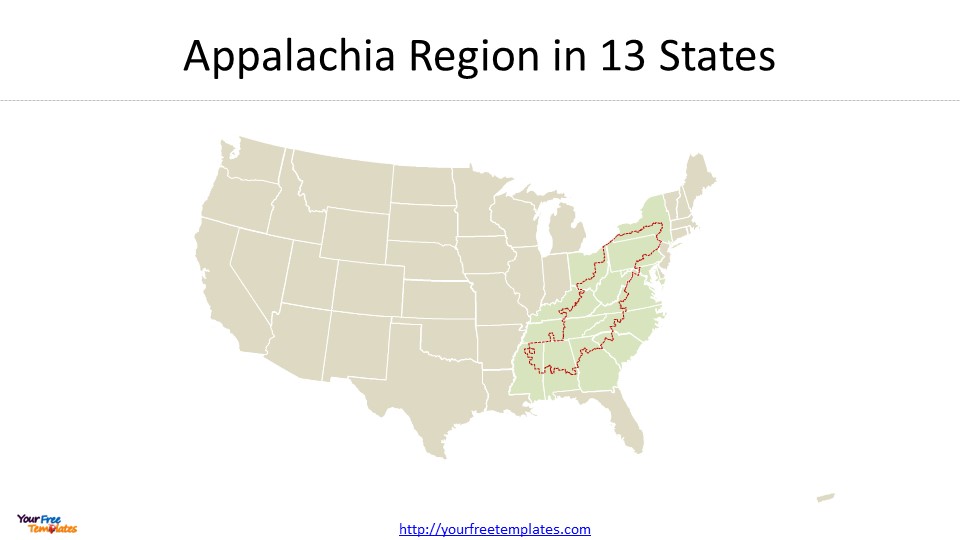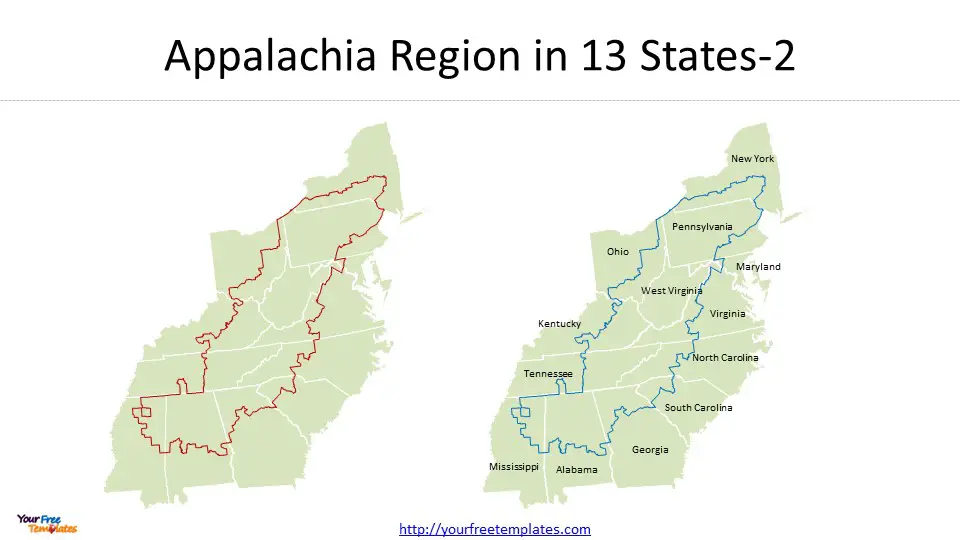The Appalachia map template in PowerPoint format includes three slides. Firstly, we have the Appalachia map template for the region outline. Secondly, we present Appalachia outline in the US State map. In the end it is Appalachia map template for the 13 states only. As the same diagram PowerPoint template series, you can also find our Data Mining, Machine Learning, cloud computing, Artificial Intelligence and BlockChain PowerPoint templates.
Located in the Eastern part of the United States, Appalachia is a cultural and geographical region that boasts rich history, diverse demographics, vibrant culture, and distinctive socioeconomic characteristics. This article serves as a comprehensive guide to understand the expanse of Appalachia, its composition, cultural heritage, and the challenges it has faced over the years.
Geographical Overview
Appalachia map – Location and Size
Appalachia stretches over 206,000 square miles, covering parts of 13 states, from the Southern parts of New York down to the Northern regions of Mississippi. The region is home to approximately 26.3 million residents, living in parts of Alabama, Georgia, Kentucky, Maryland, Mississippi, New York, North Carolina, Ohio, Pennsylvania, South Carolina, Tennessee, Virginia, and the entirety of West Virginia.

Subregions of Appalachia
Appalachia is further divided into several subregions, each with relatively homogeneous characteristics in terms of topography, demographics, and economy. This subregional classification allows for detailed analysis and understanding of the diverse facets of Appalachia.
Counties of Appalachia
The Appalachian region spans across 423 counties, spreading from Southern New York to Northern Mississippi. Each county has its unique economic and demographic indicators, contributing to the overall socio-economic landscape of the region.
Demographics with Appalachia Map
Population
The Appalachian region is home to over 25 million people, a significant portion of whom live in rural areas. The population is a blend of different ethnicities, with majorities being White Americans, and also includes federally recognized and state recognized Native American Tribal Communities.
Socioeconomic Indicators
While the region has seen significant improvements in socioeconomic factors over the years, it still lags behind the rest of the nation in several aspects. Key economic factors include poverty, per capita income, and high school graduation rates. The Appalachian Region’s economic distress is assessed annually, influencing decisions on ARC grant awards.
Education and Employment
Education, income, and employment are integral parts of Appalachia’s demographics. The region has made significant strides in these areas, but still has room for improvement. Access to computer technology and housing conditions are also part of the overall demographic picture.

Historical Overview
Early History
Native American hunter-gatherers first inhabited what is now known as Appalachia over 16,000 years ago. The region has witnessed significant historical events, including the American Civil War and the Whiskey Rebellion. The history of Appalachia is marked by economic struggles, violent conflicts, and significant cultural shifts.
Modern History
The late 19th and early 20th centuries saw Appalachia experience an economic boom, especially in Northern Appalachia. However, this boom was followed by a period of economic struggle, marked by widespread poverty and outmigration.
Recent Developments
Since the late 20th century, there have been concerted efforts to rejuvenate Appalachia’s economy and improve living conditions. Organizations like the Appalachian Regional Commission (ARC) have played a pivotal role in this regard. Despite the challenges, Appalachia continues to progress, with growing sectors such as Information Technology showing promising potential.
Cultural Heritage
Music and Folklore
Appalachian culture is renowned for its literature and music. Traditional Appalachian music has roots in Irish and Scottish fiddle music and African-American blues. The region’s folklore, influenced by European, Native American, and Biblical traditions, is rich with regional heroes and legends.
Stereotypes
Despite its rich cultural heritage, Appalachia has often been subjected to negative stereotypes, portraying its inhabitants as uneducated and backward. These stereotypes, popularized by media over time, have often led to discrimination and misunderstanding of Appalachian culture and people.

Tourism in Appalachia
Today, Appalachia is a popular tourist destination. Its mountainous terrain, stunning scenery, and diverse outdoor recreational opportunities attract millions of visitors annually. The Appalachian National Scenic Trail, a hiking trail spanning from Georgia to Maine, is one of the region’s most notable attractions.
Conclusion
Appalachia is a region of diverse experiences, marked by its rich cultural heritage, historical significance, and unique socioeconomic landscape. You can apply our Appalachia map template in your work. Despite the challenges it has faced, Appalachia continues to evolve and progress, reflecting the resilience and spirit of its inhabitants. The map of Appalachia is not just a geographical representation, but a testament to the region’s journey through history and its promising future.
For other interesting maps, pls visit our ofomaps.com
Size:590K
Type: PPTX
Aspect Ratio: Standard 4:3
Click the blue button to download the maps.
Download the 4:3 Template
Aspect Ratio: Widescreen 16:9
Click the green button to download the maps.
Download the 16:9 Template














